This article has been reviewed according to Science X's editorial process and policies. Editors have highlighted the following attributes while ensuring the content's credibility:
fact-checked
peer-reviewed publication
proofread
Single primer enrichment technology: A new genomic resource to investigate the diversity of lettuce germplasm

For the first time, the single primer enrichment technology (SPET)—a novel high-throughput genotyping method—was used in lettuce to study the genetic diversity of a collection of 160 Lactuca accessions originating from 10 countries in Europe, America and Asia, and to identify genomic regions that underpin important agronomic traits.
In recent years, technologies to investigate the genomic diversity of crops have made extraordinary progress and novel methodologies such as single primer enrichment technology (SPET) offer promising and cost-effective opportunities. SPET has so far been used in several crop plants, such as in maize, poplar, oil palm, tomato, eggplant and peach, showing its power for genotyping germplasm collections and crossing populations.
SPET was used in lettuce (Lactuca sativa L.) for the first time by a consortium of European researchers in the context of the European Evaluation Network (EVA) of the European Cooperative Programme for Plant Genetic Resources (ECPGR), with the aim to study its genetic diversity and identify genomic regions that underpin important agronomic traits.
Lettuce is a commercially important crop, widely appreciated by consumers for its fiber content and low calories. It is also a good source of vitamin C, iron, folate and different health-beneficial nutrients.
"Given the lack of cost-effective options for genotyping in lettuce, the EVA Network decided to design a SPET panel for this crop, together with IGATech, and applied it to a collection of 155 accessions of Lactuca sativa and 5 of the closely related wild species Lactuca serriola," said Pasquale Tripodi, lead author of the study and Senior Researcher at CREA, Italy.
The EVA initiative was established in 2019 by ECPGR to improve knowledge of crop genetic diversity and exploit it to breed more resilient crops that can meet the major problems facing agriculture.
"The EVA Lettuce network is one of currently five crop-specific public–private partnerships, bringing together breeding companies, genebanks and research institutes to jointly generate phenotypic and genotypic evaluation data for numerous accessions and landraces available in European genebanks," explained Sandra Goritschnig, coordinator of the EVA initiative and co-author of the study.
The plant materials in the study were selected in the frame of the EVA Lettuce Network and originated from the germplasm collections of four European genebanks: the Institute for Plant Genetic Resources "K.Malkov" (Bulgaria), the Centre for Genetic Resources, the Netherlands, the Unité de Génétique et Amélioration des Fruits et Légumes, Plant Biology and Breeding, INRAe (France), and the Nordic Genetic Resource Center (NordGen) (Sweden).
The studied genotypes encompassed cultivars, breeding materials, and landraces originating from ten different countries in Europe, America and Asia, included different horticultural types, such as Butterhead, Iceberg, Romaine, Batavia, Crisp, and were phenotyped in multilocation field trials across three countries.
Why SPET?
Compared to other genotyping methods, SPET combines the advantages of arrays and high-throughput sequencing, and has a high capacity to detect new single-nucleotide polymorphisms (SNPs), which are variations in the genetic sequence that determine the diversity among individuals in a species.
"Having a large number of SNPs increases our ability to understand the genetic diversity of a collection and investigate the function that some genomic regions play. In our case, we designed a SPET assay for 40,000 SNPs and succeeded in covering up to 96% of gene-rich regions, compared to previous studies in lettuce using different genotyping techniques, which covered only up to 27.6%. This demonstrates how effective SPET is," said Tripodi.
Also, using a fixed probes panel guarantees the reproducibility of the assay across different laboratories, unlike other sequencing methods. It also fosters the establishment of larger scientific communities that can leverage interoperable markers.
The analysis generated over 80,000 high-quality SNPs that allowed the researchers to group the accessions by type and geographic origin, and to identify gene associations for seed color, leaf color, leaf anthocyanin content and bolting time.
"We are very excited about this new application of SPET in lettuce, which confirmed previous findings, refined our knowledge of the genomic position of some agronomic traits and demonstrated the power of SPET to investigate the genetic diversity of germplasm collections, thus allowing a better characterization of lettuce collections. The SPET panel will be a cost-effective tool for both breeders and researchers in lettuce," concluded Goritschnig.
The findings are published in the journal Frontiers in Plant Science.
More information: Pasquale Tripodi et al, Development and application of Single Primer Enrichment Technology (SPET) SNP assay for population genomics analysis and candidate gene discovery in lettuce, Frontiers in Plant Science (2023). DOI: 10.3389/fpls.2023.1252777
Journal information: Frontiers in Plant Science
Provided by The Alliance of Bioversity International and the International Center for Tropical Agriculture





















